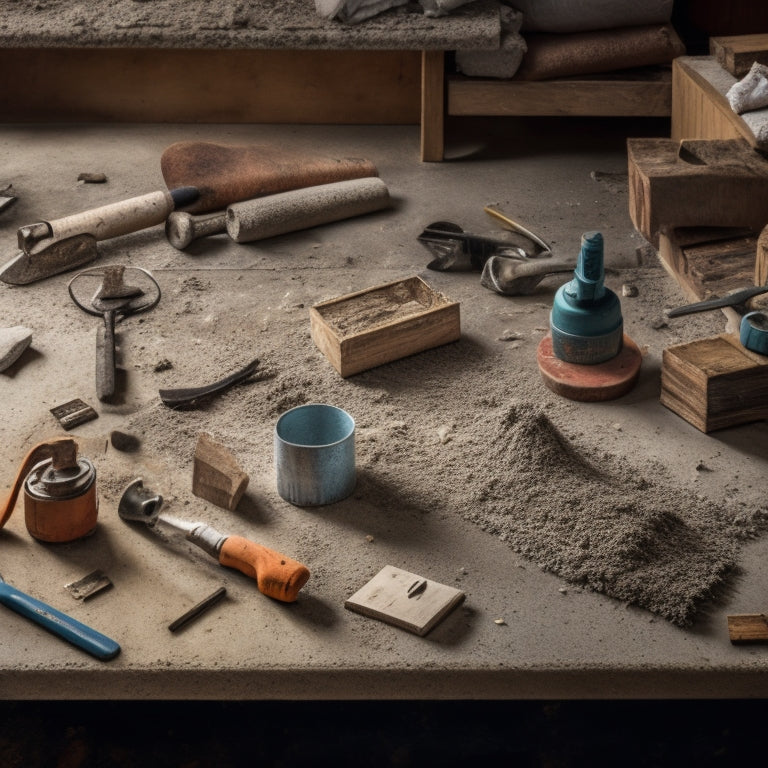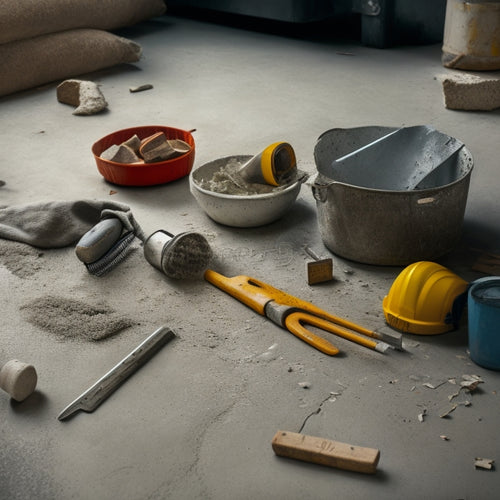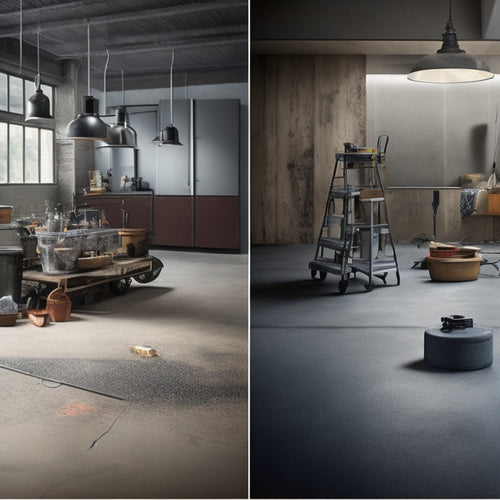
Top Tools for Removing Flooring on Concrete
Share
When removing flooring from concrete, you'll need a range of specialized tools, including pry bars, hammers, and chisel sets for demolition, as well as floor scrapers and putty knives for scraping and chiseling. Adhesive removers, such as chemical-based products and mechanical tools, are also essential for breaking down stubborn adhesives. For heavy-duty removal, consider using grinders, demolition hammers, and durable chisels. Don't forget edging and corner tools, like adjustable handles and replaceable blades, for precise control in tight spaces. With the right tools, you'll be well-equipped to tackle your flooring removal project - and by exploring these options further, you'll uncover even more efficiencies.
Key Takeaways
• A pry bar is essential for breaking up old flooring materials, requiring controlled pressure to prevent concrete damage.
• Floor scrapers, putty knives, and chisel sets are vital for precise removal of flooring materials, especially tile, vinyl, or epoxy coatings.
• Adhesive removers, such as chemical-based products and mechanical tools, help accelerate the removal process and ensure a smooth finish for future installations.
• Heavy-duty flooring removal tools, including grinders, demolition hammers, and durable chisels, are designed for thick materials like ceramic tiles and hardwood.
• Safety equipment, including dust masks, safety glasses, and heavy-duty gloves, is crucial for protecting workers from airborne particles, flying debris, and hazardous materials.
Essential Demolition Tools Needed
You'll frequently reach for a pry bar, hammer, and chisel set when tackling flooring removal projects on concrete, as these vital demolition tools enable you to effectively break up and remove old flooring materials.
These tools are the foundation of flooring removal techniques, and mastering their use is essential for a successful project. When using a pry bar, always maintain a firm grip and apply controlled pressure to avoid damaging the surrounding concrete. A hammer is perfect for tapping the chisel into place, and its weight helps to dislodge stubborn flooring materials.
To prolong the life of your tools, incorporate tool maintenance tips into your routine. Regularly clean and inspect your tools for signs of wear, and store them in a dry, protected area. By following these best practices, you'll guarantee your vital demolition tools remain in top condition, ready to tackle even the most demanding flooring removal projects.
With these tools and techniques, you'll be well-equipped to take on any concrete flooring removal project that comes your way.
Scraping and Chiseling Tools
When tackling stubborn flooring adhesive or thinset, scraping and chiseling tools like floor scrapers, putty knives, and flat chisels are essential for effectively breaking the bond between the old flooring material and the concrete substrate. These tools are particularly useful when dealing with flooring types like tile, vinyl, or epoxy-based coatings, which can be notoriously difficult to remove. By employing scraping and chiseling techniques, you can efficiently dislodge the flooring material from the concrete, making it easier to remove.
As you work, it's vital to use the correct removal techniques to avoid damaging the concrete substrate. For example, using a floor scraper with a curved or angled blade can help you get under the flooring material and pry it loose without scratching the concrete.
Putty knives, on the other hand, are ideal for scraping away thin layers of adhesive or thinset. By combining these tools with the right techniques, you'll be able to remove even the most stubborn flooring with ease, leaving you with a clean slate for your next project.
Adhesive Removers for Concrete
When you're removing flooring from concrete, you'll need an adhesive remover that can effectively break down the bonding agents without damaging the surface.
You'll want to choose a product that can guarantee a safe concrete surface, free from residue and damage, and also consider fast remover options to save time and labor.
Effective Adhesive Breakdown
Breaking down stubborn adhesives on concrete flooring requires the right tools and techniques, starting with the application of a suitable adhesive remover that can effectively dissolve and dislodge the old adhesive.
You'll need to choose a remover that's compatible with the specific adhesive type, whether it's epoxy, acrylic, or polyurethane-based. For instance, a solvent-based remover might be effective for epoxy-based adhesives, while a water-based remover is better suited for acrylic-based adhesives.
When applying the remover, make sure to follow the manufacturer's instructions and take necessary safety precautions. You may need to apply the remover multiple times, allowing it to dwell for a specified period before scraping off the adhesive residue.
Effective removal techniques include using a putty knife or scraper to gently pry off the adhesive, or using a floor scraper with a carbide-tipped blade for more aggressive removal. Be careful not to gouge or scratch the concrete surface, as this can lead to additional repair work.
Safe Concrete Surface
To guarantee a safe concrete surface, you'll want to select an adhesive remover that's specifically designed for concrete, as it will be formulated to effectively dissolve and remove adhesives without damaging the underlying surface.
This is vital for concrete surface preparation, as it guarantees a smooth and even finish for future flooring installations.
When choosing an adhesive remover, look for products that are labeled as 'concrete-safe' or 'non-corrosive' to confirm they won't damage the concrete.
Additionally, always follow the manufacturer's instructions for application and dwell time to avoid damaging the surface.
Safe demolition practices also dictate that you wear protective gear, including gloves, safety glasses, and a mask, to prevent exposure to harsh chemicals.
Fast Remover Options
By opting for fast remover options, you can expedite the adhesive removal process on concrete, saving valuable time and labor while still achieving effective results. Adhesive removers for concrete, such as chemical-based products or mechanical tools, can greatly reduce the time and effort required to remove flooring. These fast remover options utilize quick lift methods, allowing you to efficiently strip away adhesives and residues from the concrete surface.
When selecting an adhesive remover, consider the type of flooring being removed, as well as the age and condition of the adhesive. Some removers are specifically designed for epoxy-based adhesives, while others are better suited for acrylic or polyurethane-based adhesives. Look for products that offer efficient tear out capabilities, reducing the risk of damaging the underlying concrete.
Additionally, consider the environmental and health implications of the remover you choose. Opt for eco-friendly and low-VOC (volatile organic compound) products to minimize exposure to harsh chemicals.
Heavy-Duty Flooring Removal
You'll need a robust set of tools for heavy-duty flooring removal, such as floor scrapers, grinders, and demolition hammers, to effectively tackle thick, stubborn flooring materials. These tools will help you develop effective flooring techniques and removal strategies to get the job done efficiently.
| Tool | Description |
|---|---|
| Floor Scrapers | Heavy-duty scrapers for removing thick flooring materials like ceramic tiles and hardwood |
| Grinders | Industrial-grade grinders for grinding concrete and removing old adhesives |
| Demolition Hammers | Powerful hammers for breaking up and removing stubborn flooring materials |
| Chisels | Durable chisels for scraping and removing old flooring materials |
| Safety Gear | Essential safety gear like gloves, goggles, and masks for protecting yourself on the job |
When it comes to heavy-duty flooring removal, having the right tools is vital. By investing in these essential tools, you'll be able to develop effective flooring techniques and removal strategies that will help you complete the job quickly and efficiently. Remember to always prioritize safety and take necessary precautions to avoid injuries and damage to the concrete surface.
Edging and Corner Tools Required
When removing flooring from concrete, you'll encounter edges and corners that require specialized tools to get the job done efficiently.
You'll need to choose the right edge scraping tools to effectively remove old adhesives and flooring material from tight spaces.
In corners, corner chiseling options will come into play to break up and remove stubborn flooring fragments.
Edge Scraping Tools
To remove flooring from concrete surfaces, you'll need edge scraping tools specifically designed for edging and corner work, as these areas require precise control and maneuverability. Edge scraping techniques involve using the right tools to scrape and remove flooring material without damaging the underlying concrete. For effective edge scraping, you'll need tools with adjustable handles and replaceable blades.
Here are some edge scraping tools you should consider:
| Tool | Description |
|---|---|
| Edge Scraper | Adjustable handle with replaceable blade for precise control |
| Corner Scraper | Angled blade for scraping corners and tight spaces |
| Scraper with Offset Handle | Ergonomic design for reduced fatigue and improved maneuverability |
| Scraper with Retractable Blade | Blade retracts for safe storage and transport |
Remember to maintain your edge scraping tools regularly to guarantee peak performance. Scraper maintenance tips include cleaning the tool after each use, storing it in a dry place, and sharpening or replacing the blade as needed. By using the right edge scraping tools and techniques, you'll be able to remove flooring efficiently and effectively.
Corner Chiseling Options
By leveraging edging and corner tools, such as corner scrapers and chisels, you can effectively remove flooring material from tight spaces and corners, where a standard scraper may struggle to reach or maneuver. These specialized tools are designed to navigate complex angles and curved surfaces, allowing you to remove flooring material with precision and control.
When it comes to corner chisel techniques, it's important to choose the right tool for the job. You'll want to take into account the type of flooring material, the size and shape of the corner, and the level of force required to remove the material. For example, a carbide-tipped corner chisel is ideal for removing thick, stubborn flooring material, while a stainless steel chisel is better suited for more delicate surfaces.
Chisel material options also play a significant role in effective corner chiseling. High-carbon steel chisels, for instance, offer exceptional strength and durability, making them perfect for heavy-duty applications. On the other hand, titanium chisels are lightweight and corrosion-resistant, making them ideal for precision work.
Safety Equipment for Removal
You'll need a range of safety equipment to protect yourself from the hazards associated with removing flooring on concrete, including dust masks, safety glasses, and heavy-duty gloves. These essential tools will shield you from airborne particles, flying debris, and harsh chemicals.
Don't compromise on your safety – invest in high-quality protective gear that meets industry standards.
As you develop your safety protocols, consider the specific risks associated with each removal method. For example, if you're using a jackhammer, you'll need ear protection and a face shield to guard against loud noises and flying concrete fragments.
When working with chemical-based adhesives, wear a respirator and protective clothing to prevent skin and respiratory irritation.
Always inspect your equipment before use and maintain a clean, organized workspace to minimize tripping hazards and other accidents.
Frequently Asked Questions
Can I Remove Flooring Without Damaging the Underlying Concrete?
You can remove flooring without damaging the underlying concrete by employing precise flooring techniques that prioritize concrete preservation, such as carefully scraping and prying, and using specialized tools to minimize surface impact.
How Do I Dispose of Old Flooring and Adhesive Materials?
You'll need to separate flooring materials for disposal, considering local regulations for hazardous waste like asbestos or lead-based adhesives; explore adhesive recycling options, and check with facilities that accept construction waste for proper flooring disposal.
Are There Any Eco-Friendly Adhesive Removers Available?
You're wisely seeking a greener approach to adhesive removal; fortunately, you'll find eco-friendly alternatives that gently coax old adhesives away, such as biodegradable options and natural solvents, which are not only effective but also gentle on the environment.
Can I Rent Flooring Removal Tools Instead of Buying Them?
You can rent flooring removal tools, comparing costs to buying, and consider flooring rental services that offer eco-friendly options, making it a cost-effective and sustainable solution for your project.
Do I Need a Permit to Remove Flooring in a Commercial Building?
"As you crack open the commercial renovation playbook, you'll find that flooring regulations are the unsung heroes; you'll need to obtain necessary permits, ensuring a smooth, hassle-free process that meets local building codes and standards."
Conclusion
You've finally reached the end of the flooring removal journey. Congratulations on surviving the dust, sweat, and tears!
As you gaze upon the newly exposed concrete, remember that the real heroes are the tools that made it possible. From the trusty scraper to the mighty adhesive remover, each one played a vital role in liberating your floor from its outdated covering.
Now, take a deep breath and bask in the glory of a job well done!
Related Posts
-

Top 10 Concrete Repair Tools for Small Fixes
You'll need the right tools to tackle small concrete repairs efficiently and effectively. When it comes to small fixe...
-

Essential Tools for Epoxy Concrete Floor Repair
You'll need a thorough arsenal of specialized tools to guarantee a successful epoxy concrete floor repair. Floor prep...
-

Top Tools for Revamping Old Concrete Floors
You'll need a range of tools to revamp your old concrete floor, starting with epoxy, acrylic, or polyurethane paint, ...


